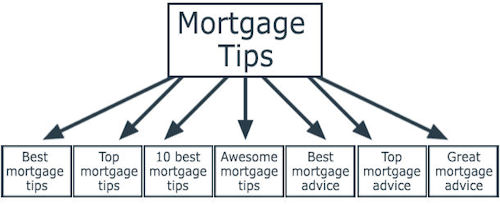Long Tail Content For SEO — 2013 & Beyond
There was the old way of doing SEO for the long tail. It worked for a long time, and lots of people made lots of money doing it. But those days are gone. What was the old way, you ask? In a nutshell: Research a long list of long-tail keywords Create a page for each […]
There was the old way of doing SEO for the long tail. It worked for a long time, and lots of people made lots of money doing it.
But those days are gone. What was the old way, you ask? In a nutshell:
- Research a long list of long-tail keywords
- Create a page for each long-tail term
- Give each page a title tag with the key phrase at the very start of the title tag
- Implement a header tag with the same key phrase at the start of it
- Write some simple blather type text that repeats the key phrase once or twice and arguably adds some additional value
- Focus the page on conversion
Often, all you’d end up with is a site that simply tried to capture traffic for every imaginable related search phrase:

Simple planning, easy execution, not so great user experience — but who cares? Lots of money to be made!
This approach got so ingrained in our online culture that there are still thousands (perhaps tens of thousands) of publishers still doing it — and they have no idea why Google does not like them anymore. The answer to that question is actually simple:
Compared to sites that offer authoritative information, sites using the above formula suck — and Google does not like to offer users sites that suck in their results!
The above statement seems fairly obvious, yet many have found it hard to accept. After years of creating websites that “worked” and made tons of money, people lost sight of the fact that those websites were actually not very good. A site that offers efficient ways to buy something fast, with little other value, is not a good site when compared to one that does offer other value beyond ease of conversion.
If you have a straight e-commerce experience, that might be okay if you have a major brand, as this offers a different element of value to the overall site experience. So, if you are not a major brand, and you are looking to cover a fair number of long tail terms …
… What To Do Now?
Since the old formula is a dying dinosaur, what can you do instead? Great question! Here’s the new approach:
- Take your best and brightest and brainstorm. Gather your team in a conference room and come up with ideas for pages/content you might want to create. Do this before you get too deep into your research. If you are really good at your business, you have a lot of domain expertise already — so get the best out of your internal knowledge before you corrupt it with additional “facts.” Your own creativity will often produce ideas that extensive research does not.
- Brainstorm user needs. Figure out the top 5 (or more) things users want to know when they land on a page offering products or services like yours. Interview past users, poll prospective customers, and do online research within your niche. Map out content that addresses common consumer questions in as much detail as you can. As you do this, take the time to go much deeper than you will need to on the page itself — it’s best to have too much information at your disposal rather than too little.
- Research complementary products and services. Now that you have thought in detail about what people need from your product or service, what are the other things that people will want at the same time that you don’t offer? Does it make sense to create content focused on those things? If feasible, use this information to create a comprehensive solutions guide that helps prospects with every aspect of the problem they are trying to solve, not just the piece that you address directly.
- Research what the bulk of competitors are doing. Use your competitors as a baseline — after all, you will need to do better than they are. Copying your competitor’s approach is a bad strategy. Competitors may get away with a crappy site experience, but it’s a bad plan for you. You should plan for excellence — this is the best way to build a sustainable long-term strategy.
- Research what authoritative competitors are doing. You looked at the bulk of your competitors to get a baseline. Now, look at the very top people in your space to see what they are doing differently. This will give you some additional clues. I like to delay this step because it is best to not corrupt your creativity in the early stages. But, now you can use it to develop a whole set of fresh, new ideas.
- Do some quantitative research. Now that you have the basic ideas, start doing some research into keyword volumes to help you prioritize what is most important. This is only one input into the equation — don’t overlook the importance of the user experience, too. Just because something has twice as much search volume does not make it front and center if it is really a tertiary piece of information to a user. I have a strong preference to put the most important information to a visitor front and center, and treat keyword volume as a secondary factor to alter the balance in otherwise close calls.
- Create an initial design, and obtain feedback. Now that you have a sense of priorities, develop one or more strawman designs with the goal of obtaining feedback. Honestly, it can be surprisingly cheap to get feedback on different mockups, using services such as UserTesting.com or even Mechanical Turk.
- Gut check: does the page deserve to exist? You can actually do this at any stage in the process, but you should do it at least once every time a page is published. Is there a legitimate reason for the page to exist? I should refine the question a bit: does it add some redeeming, real value to the Web or your website? If you have a blue widgets webpage, you probably don’t need a round blue widgets webpage, a square blue widget webpage, and 4″-diameter round blue widgets with blue trim webpage, etc.
Summary
The key message I am pushing here is the shift toward a more user-content-centric view of the world. SEO is not dead, but it can no longer be the single cause of the website for your business. Priority #1 has to be the user experience — from there, you can add SEO wisdom to the mix.
That said, you can still create pages for the long tail. But you will have to invest more than you would have had to three years ago.
Contributing authors are invited to create content for Search Engine Land and are chosen for their expertise and contribution to the search community. Our contributors work under the oversight of the editorial staff and contributions are checked for quality and relevance to our readers. The opinions they express are their own.
Related stories
New on Search Engine Land
